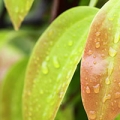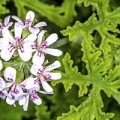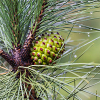The Secret of Roman Chamomile Essential Oil is Revealed
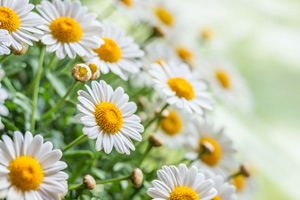 Roman chamomile essential oil is without doubt one of the most versatile of all the oils used in aromatherapy today.
Roman chamomile essential oil is without doubt one of the most versatile of all the oils used in aromatherapy today.
In fact it probably comes second only to lavender when needing an oil with a wide range of applications and therapeutic benefits for therapy or natural skin care.
It is also the most popular of the three chamomile oils available, the other two being German chamomile (Matricaria recutita) and chamomile maroc (Ormenis multicaulis), which, incidentally, is not a true chamomile anyway. Think of this species as a distant cousin.
Many older aromatherapy and botanical books refer to the botanical name of Roman chamomile as Anthemis nobilis, but more recently botanical texts refer to this plant as Chamaemelum nobile. Don’t be confused by this since both names are correct and do refer to the same plant.
Physical description
Chamaemelum nobile belongs to the Asteraceae family and is a low growing, creeping plant with flowers and leaves that typically reach a height of up to of 25 centimetres (10 inches). It is an herbaceous perennial with strong fibrous roots and long fibres, and the whole plant is aromatic.
The fibrous root is perennial, the stems are freely branching, hairy and covered with feathery pinnate leaves. The wild growing variety has single white flowers similar to a daisy but larger, with a convex, yellow disk and numerous white, spreading, or reflexed rays. The cultivated variety has double white florets arranged around the yellow centre, which is known as the receptacle.
This species of chamomile is native to southern and western Europe where it can be found growing wild throughout the temperate regions. Roman chamomile essential oil is produced in many countries including Argentina, Belgium, France, Hungary, Italy, USA and the United Kingdom. Of all these origins, the oil produced in the U.K. is considered by many experts to be the finest quality.
Traditional uses
Also known as English chamomile, true chamomile and common chamomile, the ‘noble’ chamomile plant has been used since ancient times for its healing properties. Throughout Europe C. nobile has proven to be highly effective in treating headaches, insomnia, stomach ailments and disorders of the kidney, liver and bladder, helping make it one of the most popular and safe household herbal remedies known since records began.
The ancient Egyptians are known to have used ‘chamomile’ in skin care preparations, incense and medicine, and due to its impressive curative properties for acute fever they dedicated it to their sun god Ra. Poor record keeping means we can’t be certain which species of chamomile was used predominantly by the Ancient Egyptians. During the Middle Ages C. nobile was commonly used as a ‘strewing’ herb at public gatherings and celebrations, and when walked upon the plant would diffuse its wonderful fragrance into the air.
Harvesting and distillation
Harvesting takes place during late June or July in the U.K., although heavy rain often causes havoc with the harvesting schedules of the unfortunate British farmer. The crop must be harvested when it contains the highest yield of oil, and test distillations followed with gas chromatography analysis are used to determine this. Harvesting will not begin until the test results show that the oil meets all the predetermined quality parameters, and the forthcoming weather is suitable.
After cutting, the flower heads are allowed to sun-dry for a short period before being subjected to steam distillation to extract the beautiful, pale blue essential oil. The flowers typically yield between 0.4 and 1.0% of essential oil. A good quality English oil is herbaceous, sweet and fruity, with a subtle hay or tea-leaf nuance.
Roman chamomile essential oil in aromatherapy
Despite the fact that Roman chamomile oil doesn’t contain the high amounts of chamazulene that are present in German chamomile oil, it nonetheless has an appreciable anti-inflammatory effect that helps ease various sprains, strains and swellings when used in massage or with a cold compress.
Muscular aches and pains can be treated effectively using Roman chamomile essential oil in massage, baths and compresses. Blend it with sweet marjoram, black pepper, helichrysum, plai, or rosemary for the best results for these type of ailments. Arthritis and rheumatism also respond well to massage, baths and compresses containing Roman chamomile oil, and it has an antispasmodic effect that is highly effective for relieving abdominal or period cramps as well as nausea.
Irritated skin conditions respond extremely well to Roman chamomile oil, but when using it for eczema or psoriasis use a good hypoallergenic lotion or cream base, rather than a vegetable carrier oil which can aggravate these conditions.
When inhaled from a tissue, Roman chamomile essential oil offers welcome relief for hay fever sufferers due to its anti-allergen effect. It offers relief to allergic rhinitis and dust allergies too, bringing soothing comfort to irritated and inflamed nasal passages. These properties are also extremely useful for calming and soothing the airways for those with asthma too.
Used in a diffuser or burner, Roman chamomile essential oil is perfect essential oil for calming down noisy children, angry partners and your frazzled nerves. Be sure to include it in any blends for stress, insecurity and states of anxiety. If you have trouble sleeping add a few drops to a nice warm bath or use it in a relaxing massage before retiring to bed. Add a few drops to a diffuser in your bedroom as well, so that the air is filled with its relaxing aroma when you slip between the sheets.
Roman chamomile oil is a middle/top note that blends easily with most other essential oils and adds a gentle warmth in a very subtle way. Try mixing it with bergamot, clary sage, geranium, jasmine, lavender, linaloe, marjoram sweet, neroli, rose, and sandalwood.
Browse Quinessence Roman Chamomile Essential Oil
Copyright © Quinessence Aromatherapy Ltd 2022.

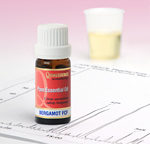 The secret to getting the best possible results in aromatherapy is to only use the very highest quality, pure essential oils that were sourced from the best growing regions.
The secret to getting the best possible results in aromatherapy is to only use the very highest quality, pure essential oils that were sourced from the best growing regions.
